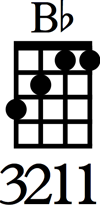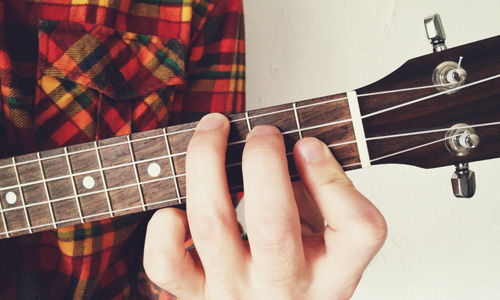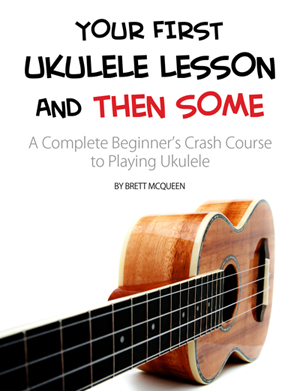 A common question I see in the Strumming Tricks video lesson course, as well as in email, is about how to play a Bb chord. If you aren’t familiar, a Bb chord is played on the ukulele as shown in the diagram to the left.
A common question I see in the Strumming Tricks video lesson course, as well as in email, is about how to play a Bb chord. If you aren’t familiar, a Bb chord is played on the ukulele as shown in the diagram to the left.
As normally instructed, to play a Bb chord, use your index finger to hold down or barre the bottom two strings of the ukulele at the 1st fret; place your middle finger on the 2nd fret of the third string and your ring finger on the 3rd fret of the top string, as shown in the following picture.

A common way to play a Bb chord
This position requires you to bend your index finger in what can seem like a really difficult and uncomfortable way. If you struggle with stiffness or even arthritis in your fretting hand, this position can seem near impossible. Not to mention, this way of playing a Bb chord requires quite a bit of strength.
In my conversations with you, a lot of you have found an alternative way to play a Bb chord that works extremely well. To play a Bb chord, rather than barring only the bottom two strings at the 1st fret, barre all the strings with your index finger. This means, you hold down all four strings at the 1st fret with your index finger. Then, position your middle finger on the 2nd fret of the third string and your ring finger on the 3rd fret of the top string. Check out the following picture to see a Bb chord played in this alternate position.

An alternate way to play a Bb chord
Note: Ensure the end of your thumb is firmly planted on the neck of the ukulele to provide leverage and support.
The benefit to this alternate position is that you are able to keep your index finger extended, rather than bending it in an awkward way. Many find this much more comfortable, and because you are using the entire index finger to hold down the strings, the amount of strength and energy required to fret the strings is a little less.
I want to hear from you. How do you play a Bb chord? Any tips that you have for your fellow ukulele players? Post your comment below!

